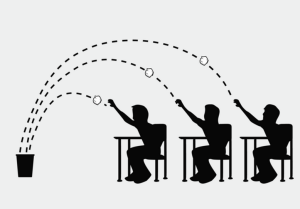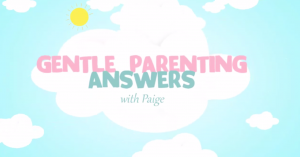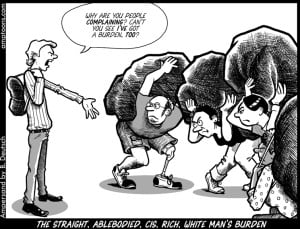
Students walking together outdoors, smiling at one another.
A few years ago, I met a white linguist interested in learning the Lakota language. He mastered several from around the globe, but had never attempted any of the thousands of languages indigenous to the Americas.
Language demands communication – such is its nature – and learning and/or teaching a language is the only way to guarantee its survival.
So I gave the linguist several resources, including the names and contacts of the best Lakota language teachers I knew. He was quick to follow up with those resources, which made his interest in the language seem genuine.
Fast-forward about a year later, and I’m in an online forum for Lakota language learners and see a post from him suggesting changes to the language and how it’s learned, i.e., “Wouldn’t this phrase make more sense said like this versus like this? In Latin, sentence structure looks like this…”
He then turns around and says he’s compiling all the things he’s absorbed from Lakota elders and teachers (as well as the other world languages he’s learned) into his own, free-access language program.
While I’m sure the linguist had good intentions, there’s a lot wrong with what he’s doing here (namely, that he’s centering Western language methods and learning in order to create his own language product versus uplifting existing Native-led efforts), and this situation provides a nice example of why some Native people are hesitant or resistant to teaching non-Natives our languages.
I get those concerns.
While cross-cultural learning (including language sharing) is undoubtedly a good thing, learning a language like Lakota isn’t the same as learning a language like Spanish or Mandarin, and an extra step (or several) is needed in order to learn (and/or teach) in a non-oppressive way.
Here, I provide white folks interested in learning a Native language with three questions to ask yourself before diving in.
But first, a few qualifiers.
While this topic could easily be extended to learning Indigenous languages in a global sense (for example, Canada, Central/South America, Pacific Islands, Australia, and so on), I’ll be focusing on Native American languages – those tribes within the United States, and specifically the Lakota language.
Second, though people of any racial demographic can be oppressive in their language learning/teaching, this article is written for white folks. Because limited time and space. And racial power systems.
Finally, I’m taking the sometimes unpopular stance that all language should be accessible to those who wish to communicate with their fellow human beings as a fellow human being.
However, there are many who believe, for legitimate reasons, that Native languages are for Natives only. And that’s okay.
Question #1: Why am I learning this language?
In order to become a non-oppressive language learner, it’s important to really unpack your motivations for wanting to learn an Indigenous language.
Common reasons include:
- required coursework (say, for an education degree);
- employment (you’ll be working within a tribal community, or you want to include the language in your linguistic business, like my friend above);
- white saviorism (the language is endangered and you think you can do a better job than tribal community members at saving it);
- you claim to have some kind of Native ancestry;
- and/or just because (it’s a free country!).
Chances are one of these is you, to some extent.
That’s just the way US society operates: Western culture feeds on capitalistic notions of individual success, so it’s a good bet the motivations of non-Natives learning Native languages are centered on personal gain, profit, and/or entitlement.
There’s a stark contrast from white motivations to those of Native learners: Though we might also have economic reasons, we’re learning for cultural survival.
Various Chinese dialects, Spanish, English, Hindi, and Arabic are the most widely spoken languages in the world. We’re talking billions of speakers.
My tribe’s language is endangered; fewer than an estimated 6,000 self-identified people speak it fluently on South Dakota’s reservations.
The point is this: Lakota people know our cultural survival – including spiritual, familial, and land-based understandings – is intimately tied to the fate of our language.
And we’re fighting to keep our language and culture alive for generations to come.
So when a white person gives what amounts to be selfish reasons for learning our culture, you can imagine the hurt and angry reactions.
Ours is not a language that can or should be casually observed.
There really is only one way to learn a language like Lakota, and that is to fully immerse yourself in the community, culture, history, and issues.
I say this as someone who – living in Phoenix – is physically disconnected from my tribal community in South Dakota. Though I read Lakota dictionaries, listen to Lakota language audiobooks, and practice the basics with my daughter, I’ll never become fluent cut off from Oceti Sakowin lands and people.
The takeaway for white learners is this: No one can make you care – that’s on you – and until you prove it (probably over and over and over again), your motivations are suspect.
Question #2: How will I center tribal perspectives as I learn/teach this language?
Most white folks learn other languages only insofar as those languages relate/translate to English.
For instance, “What’s the word for ‘bathroom’ in x language?” versus “To be respectful, should I ask certain people in specific situations about things relating to body functions?” Learning cultural intricacies like the value of interpersonal relationships comes later, if at all.
Furthermore, we live in an era where an English-only mindset dominates one of our nation’s top political parties.
A phrase like “We speak English in America!” completely bulldozes this land’s Indigenous history, people, and issues.
Operating with the English language – and therefore, Western culture – as the default can be triggering to Indigenous people trying to save languages like Lakota, which has a violent history with Western colonizers and the English language.
It wasn’t long ago, for instance, that the US government tried to first eradicate Native people and then our cultures and languages through boarding schools and other assimilation policies.
Some of my relatives and many of my ancestors attended these boarding schools as young children and recall the physical and emotional punishments they endured for speaking Lakota.
That kind of historical trauma isn’t something a white language learner can ever fully comprehend – and they may even devalue those experiences with “get over it” erasure rhetoric.
This is why Native perspectives must be centered in your learning.
Indigenous speakers are crucial in this regard. If you must learn from someone who isn’t Native, go the extra step and seek out Indigenous teachers on your own (many are on YouTube).
Always source materials back to tribal authors and content creators and question the legitimacy of resources created by non-Natives.
Studying and teaching Native languages must be done with intention and purpose to promote the people and their cultural values you’re learning from and about.
Here’s an example: Recently, a radio show hosted a discussion about who can/should study Native languages. The guests were two Native women and a white man who leads a Lakota immersion school.
The show itself was drama-free, but afterwards, on social media, the white teacher immediately went on the defensive. He and others made degrading remarks about one of the Native women who challenged white motivations and expertise (in general and not directed at him) on air.
These harmful comments were triggering; Native women experience violence at more than twice the rate of any other race.
Those of us who saw the post asked, “You teach Lakota language but engage in anti-woman behavior? That totally goes against everything Lakota culture is.”
It’s also important to recognize how your whiteness takes up space (including time and energy) meant for Natives.
My friend took several Dakota language classes in undergrad and grad school. Many of her classmates were white, and she recalls how they would dominate the classroom and demand answers to basic cultural questions (“What is smudging?” or “Why are buffalo important?”) that could easily be Googled.
They would also spend valuable class time arguing with their Native classmates about the best way to learn and/or teach the language. Additionally, many white students – even those who were going to teach in immersion programs – refused to learn about modern Native issues, calling things like environmental justice and cultural appropriation “irrelevant” to teaching.
These behaviors and attitudes won’t benefit you or your future students. Centering Indigenous perspectives, including cultural values and contemporary interests, will.
Question #3: How will I handle criticism from Indigenous people?
That you as a white person can simply choose to learn a Native language however, wherever, and from whomever you like is the epitome of privilege.
Consider:
- Native people weren’t allowed to legally practice our own spiritual beliefs until the American Indian Religious Freedoms Act was passed in 1978. My own Lakota people were massacred at Wounded Knee by the U.S. military for reasons linked to the ceremonial Ghost Dance. Remember: Language, culture, and spirituality are intimately tied.
- Boarding schools beat the language out of Native children. Those children grew into adults who sometimes refused to speak their Indigenous language for fear of putting the next generation in the same abusive situation.
- Language classes and/or transportation to classes can be inaccessible to Natives whose communities are often plagued by extreme poverty and job scarcity, poor or non-existent health (including mental health) care, and even severe environmental issues.
- In urban areas (where some 70% of Natives reside), there are often no opportunities for Natives to learn their specific tribal languages from fluent community members.
- Native youth have the lowest educational achievement rates and the highest suicide rates of any racial demographic. Many health and social service experts agree a positive correlation exists between cultural teachings, including language learning, and mental health and educational outcomes.
In other words, learning our Indigenous languages could help save lives and better Native futures, but systemic barriers make access difficult, if not impossible, for many Native people.
Knowing this, overcoming criticism doesn’t have to put you in a defensive position.
I encourage you to ask what expectations the tribal community has of you and other non-Natives learning the language. Some communities, for instance, ask that you dedicate a certain number of years to teaching the language back to tribal youth.
Additionally, accept and appreciate that there are some things you don’t get to learn about, like ceremony.
Do you, as a non-Catholic, cruise through mass demanding to sample the body and blood of Christ? No, that would be inappropriate and disrespectful. Likewise, Native people have serious boundaries that can’t be crossed by outsiders.
Finally, understand there’s a difference between “fluency” and “expertise” when it comes to language and culture. The former is achievable; the latter is not if you’re non-Native.
Undoubtedly, someone, somewhere will call into question your motivations for wanting to learn a Native language.
Welcome this criticism and be open about your intentions. You’ll get a lot accomplished by simply acknowledging your privilege, your place within the tribal community, and Native criticism as valid and worth learning from.
***
I’ve often heard from Lakota language experts that ours is a living language.
As a traditionally oral language, it requires breath and heartbeat in order to survive – not paper, pen, or wires. It has its own DNA full of history, trauma, joy, values, spirituality, and more.
It evolves.
That might be a reason the Oceti Sakowin never wrote down our languages; a progressive culture is almost guaranteed when things aren’t written in stone.
What does this all mean? Learning a Native language is a commitment demanding community and cultural responsibility – the capacity for which many Indigenous people aren’t convinced non-Natives possess.
While I understand the concerns of those who would limit learning to Natives only, I see the possibilities and value in cross-cultural learning and sharing. I’ve worked with and learned from white language teachers who uplifted and empowered Indigenous perspectives above all else to great classroom success.
Decentering whiteness, learning from legitimate Native resources, and accepting criticism with the intention to do better are a good place to start your Indigenous language journey.
[do_widget id=’text-101′]
Taté Walker is a Contributing Writer for Everyday Feminism. She is Mniconjou Lakota and an enrolled citizen of the Cheyenne River Sioux Tribe. She lives in Phoenix and is the editor of Native Peoples magazine. Contact her at www.jtatewalker.com and read her articles here.
Search our 3000+ articles!
Read our articles about:
Our online racial justice training
Used by hundreds of universities, non-profits, and businesses.
Click to learn more




















